The Legend of Zelda: A Link Between Worlds – Review
by Edward
|
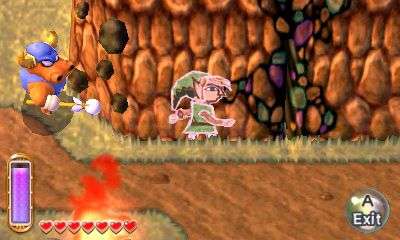 As Batman left the Joker dangling over the precipice in The Dark Knight, the defeated jester laughed and uttered “I think you and I are destined to do this forever”. Sadly, those words proved to be far more immortal than the actor who delivered them but, with the dawn of a new Legend of Zelda, I found myself quoting them as I drew the cartridge from its box and began another adventure in the land of Hyrule. I feel like I’ve been donning Link’s tunic since Game Boys have had colour and, with the exception of Spirit Tracks, never found myself tiring of the series’ long-established formula.
As Batman left the Joker dangling over the precipice in The Dark Knight, the defeated jester laughed and uttered “I think you and I are destined to do this forever”. Sadly, those words proved to be far more immortal than the actor who delivered them but, with the dawn of a new Legend of Zelda, I found myself quoting them as I drew the cartridge from its box and began another adventure in the land of Hyrule. I feel like I’ve been donning Link’s tunic since Game Boys have had colour and, with the exception of Spirit Tracks, never found myself tiring of the series’ long-established formula.
As my origins with Zelda and company began on hand-helds with Link’s Awakening, the 3DS’ A Link Between Worlds feels like a nostalgia trip in more ways than one; it not only sees the return of the top-down perspective last seen in 2004′s The Minish Cap, but proves to be the most fun I’ve had with a portable Zelda title for the last decade. For those who grew up with A Link To The Past (or caught up with the GBA re-release with multiplayer delight, Four Swords), the latest foray into Hyrule will prove more than familiar. Rather than design a new version of the land from scratch, A Link Between Worlds instead chose to adapt the now twenty-one year-old landscape into the portable realm, setting its tale six generations after the events of the SNES classic. For the time-line fiends, this also means that it’s the seventh entry in the “Hero Defeated” branch that potentially occurs at the end of Ocarina of Time, and the first title to be set there since Oracle of Ages and Oracle of Seasons twelve years ago.
 |
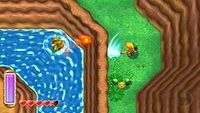 |
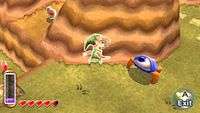 |
That being said, other than a few scant references, you won’t be losing out on much if you haven’t played A Link To The Past before as, apart from the oft-obligatory appearance of Ganon, the story doesn’t rely on the events of the title this spiritual sequel is based on. Instead, the action begins when Link is charged by his blacksmith mentor to deliver a sword to the leader of Zelda’s armed command, only to discover that he’s been defeated at the hands of Yuga, a villain capable of turning others into paintings. Despite retrieving the fabled Master Sword, our hero is unable to stop the fiendish Yuga from turning the Princess into a portrait, and is made into one himself into the bargain. However, due to a magical bracelet given to him by the mysterious Ravio, Link is able to free himself from the confines of two dimensions, and learns he’s now able to merge into walls at will, which also grants him the ability to travel through dimensional cracks into the world of Lorule. Much like the Dark World before it, this new land is a warped version of Hyrule, but the differences between Yuga’s realm and ours are more pronounced than you’d think.
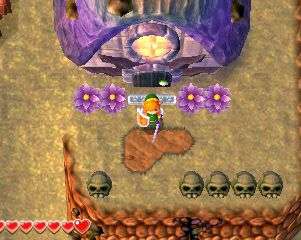 Lorule is a parallel of Hyrule gone wrong; wars over the possession of the Lorulean Triforce lead to the elders deciding to destroy it completely, leading to the life-blood of the land being cut off and descending the realm into chaos and anarchy. Enemies are more fierce, traversal is more difficult, and the remaining people are more surly, aggressive and devoid of hope. However, Link must master travelling between the parallel realms if he wishes to save the sages and put a stop to Yuga’s evil plan. In terms of an actual storyline, the narrative isn’t the strongest the series has ever seen, although there are some unpredictable moments meshed in with ones that you’ll likely see coming from a mile off. While the story sticks with the franchise’s traditional formula, the gameplay itself is where the bulk of the revolution lies.
Lorule is a parallel of Hyrule gone wrong; wars over the possession of the Lorulean Triforce lead to the elders deciding to destroy it completely, leading to the life-blood of the land being cut off and descending the realm into chaos and anarchy. Enemies are more fierce, traversal is more difficult, and the remaining people are more surly, aggressive and devoid of hope. However, Link must master travelling between the parallel realms if he wishes to save the sages and put a stop to Yuga’s evil plan. In terms of an actual storyline, the narrative isn’t the strongest the series has ever seen, although there are some unpredictable moments meshed in with ones that you’ll likely see coming from a mile off. While the story sticks with the franchise’s traditional formula, the gameplay itself is where the bulk of the revolution lies.
In a move that harkens back to The Legend of Zelda on the NES, players can tackle the dungeons in Hyrule and then Lorule in any order they wish, giving Link a chance to break free from the long-established format the series has rigidly adhered to since. Instead of discovering a dungeon, finding a new item halfway through, then using it to reach the boss and the next locale, then repeating until the final boss du jour, Link can now rent items from the enigmatic Ravio for a small fee, with the caveat that he loses them all if he dies on his travels. From the moment that the service is available, players can rent all but a few of the items needed to reach and explore the many dungeons on offer, allowing our hero to have an impressively large inventory almost from the get-go.
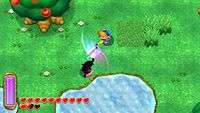 |
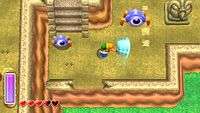 |
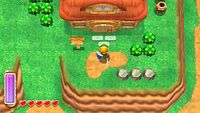 |
Eventually, players are able to buy these quest-specific items permanently, meaning that they’re no longer confiscated when you die, and you can upgrade them to greater forms. To do this, players must hunt down Mama Maimai and then her hundred children who’ve been scattered across both realms. While a fair few are hidden very conspicuously, some will only make you aware that they’re nearby thanks to their cries, forcing you to take a closer look around the environment if you want to give your inventory a boost. Link can upgrade an item for every ten of Maimai’s children found, allowing him to fire three arrows at once instead of one with a bow, a faster Hookshot that now deals damage, or larger bombs with a greater radius of attack. Finding every one of Maimai’s babies may eventually prove to be a chore to some, but this is alleviated by the fact that the map on the bottom screen comes with an option to highlight how many are left in each area of the map, allowing you to focus your search. Also, as it’s an optional side-quest to hunt them all down, there’s less of an obligation if you find yourself starting to tire of it, and I managed to find an even sixty before I found myself squaring off against the final boss.
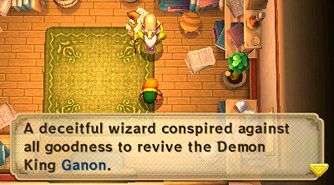 While the path I took to the final boss may have wildly differed from others’ thanks to the new-found freedom allowing me to tackle the Lorule dungeons in any order, I also felt that this may have caused A Link Between Worlds‘ only weakness – its difficulty. In short, Link’s latest outing is one of the easiest in the series’ history, and I managed to get through the entire adventure without coming close to death even once. The reason I lay this issue squarely at the new-found freedom is that difficulty doesn’t feel incremental, and instead seems to plateau early on.
While the path I took to the final boss may have wildly differed from others’ thanks to the new-found freedom allowing me to tackle the Lorule dungeons in any order, I also felt that this may have caused A Link Between Worlds‘ only weakness – its difficulty. In short, Link’s latest outing is one of the easiest in the series’ history, and I managed to get through the entire adventure without coming close to death even once. The reason I lay this issue squarely at the new-found freedom is that difficulty doesn’t feel incremental, and instead seems to plateau early on.
After the second dungeon in Lorule, I never saw my health meter dip below its halfway point, even during the boss battles, which tend to descend into “just hit this with your Master Sword” hack and slashery more than they do the puzzles of before. In the past, each boss would be its own challenge requiring you to think about how you were going to stun it before you were able to attack, and that aspect was more diminished than it has been in previous titles. Even the reliance on using the item needed for that specific dungeon has been lessened, with far more puzzles requiring the player to merge with walls and use the power of two dimensions to their advantage. Admittedly, its prominence can be forgiven due to it being a new power with plenty of potential if it means they’re not trying to wring out the last few possible puzzles they can with inventory items that have been there since the series began on the NES. That being said, you soon learn to assume that any challenges are solved by turning into a painting, and while some applications are quite clever, I only found myself having a handful of “Eureka!” moments throughout the entire adventure.
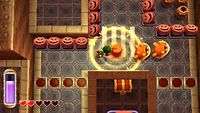 |
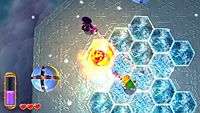 |
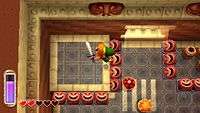 |
It’s also one of the shorter quests Link has found himself on, but it’s one of the most remarkably well-paced. The action comes thick and fast, and feels far more like it was made to be a portable adventure than the preceding DS titles ever did. Aided in this is the fact that players can save at the many weather vanes dotted around the map, and can soon recruit a witch who’ll take Link to any of the previously activated save-points in either realm, allowing you to fast-travel to your heart’s content. Granted, the world is small enough in scale that you can feasibly walk everywhere within minutes – with one mini-game proving it’s possible to dash from one side of the Hyrulian over-world to the other in less than a minute if you find the Pegasus boots on your travels – but being able to warp across the map with a tap of the touch-screen alleviates any possible back-tracking.
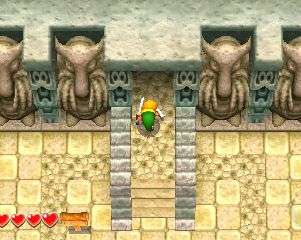 Outside of the main story, you’ll find several mini-games scattered across each world, as well as the Maimai collectathon and the series tradition of charging players with exploring the world to find heart-pieces, allowing them to increase their overall health. For the most part, they’re a quick distraction for a couple of minutes, and a great choice for short bursts of play, but can mostly be seen as a means to getting more health in the long term. Between dodging cuccos and playing baseball with an octorok, I found the most enjoyable diversion was the Treacherous Tower, which gives you a series of rooms filled with enemies, then rewards you with upgraded items, as well as a cash-flow of rupees directly proportional to how quickly you steam through the opposing hordes.
Outside of the main story, you’ll find several mini-games scattered across each world, as well as the Maimai collectathon and the series tradition of charging players with exploring the world to find heart-pieces, allowing them to increase their overall health. For the most part, they’re a quick distraction for a couple of minutes, and a great choice for short bursts of play, but can mostly be seen as a means to getting more health in the long term. Between dodging cuccos and playing baseball with an octorok, I found the most enjoyable diversion was the Treacherous Tower, which gives you a series of rooms filled with enemies, then rewards you with upgraded items, as well as a cash-flow of rupees directly proportional to how quickly you steam through the opposing hordes.
That being said, you won’t really find yourself in need of farming the mini-games to raise cash, because rupees are thrown at you with such reckless abandon that I found myself easily able to buy every one of Ravio’s items and fill my inventory with bottles and the like with two or three dungeons to spare. Those who find themselves dying frequently may not have the same privilege, but by the time the credits rolled I found myself with way more than I could feasibly spend. However, if you do find yourself in need of a serious cash injection, the best way outside of the Treacherous Tower is to throw yourself into StreetPass Battling.
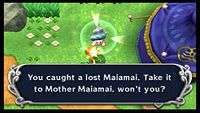 |
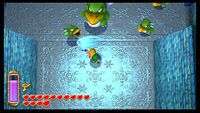 |
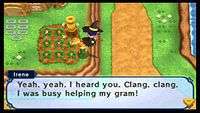 |
If you happen to StreetPass anyone whose recently played A Link Between Worlds you can square off against an AI-controlled version of their character – represented by Shadow Link – with greater rewards given against tougher foes. As your version of Link becomes stronger and better-equipped, they become a greater hassle to take on for others, but also result in a larger bounty on their heads. Customisation is admittedly limited, as since you can’t dictate their general tactics and their health, sword and tunic are all dependant on whatever you’re wearing when you update them, the most you can really do is decide what additional weapons they’ll use, with the bounty further altering based on how practical it is in battle, and whether Mother Maimai has upgraded it or not. Your performance and tactics when you square off against a StreetPass foe can also count for plenty, as there are up to fifty medals that can be awarded to you, with win conditions asking you to defeat your foe without ever taking damage, never using your sword or never moving at all. Collecting all fifty isn’t just for bragging rights either, as there’s a surprise waiting for those who manage to catch ‘em all.
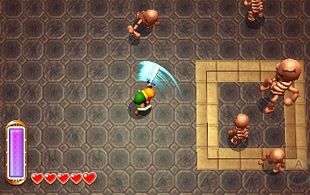 Even though it returns to the same version of Hyrule and the same top-down view-point of its SNES predecessor, the graphical overhaul given to A Link Between Worlds does a great job of breathing new life into an old classic. Taking a few aesthetic cues from the manual of the original Legend of Zelda, the ill-fated TV cartoon and a few new ideas of its own, the art style is one that will lodge itself inside your head, as each title in the series often does. The action looks smooth, the 3D effect serves to give everything a greater definition, and the cut-scenes are often great to watch and are wisely used sparingly so they don’t outstay their welcome.
Even though it returns to the same version of Hyrule and the same top-down view-point of its SNES predecessor, the graphical overhaul given to A Link Between Worlds does a great job of breathing new life into an old classic. Taking a few aesthetic cues from the manual of the original Legend of Zelda, the ill-fated TV cartoon and a few new ideas of its own, the art style is one that will lodge itself inside your head, as each title in the series often does. The action looks smooth, the 3D effect serves to give everything a greater definition, and the cut-scenes are often great to watch and are wisely used sparingly so they don’t outstay their welcome.
Where greater acclaim lies is in the soundtrack, performed by an orchestra and full of iconic tracks old and new. Admittedly, some of the newer tracks don’t have the ear-worm quality of the older tunes they evoke, but overall the music is in the franchise’s top tier, thanks mostly to the excellent orchestrations. Of particular note is the bard in Kakariko Village – as well as that town’s song itself – who, alongside his partner, will perform guitar and flute remixes of beloved Zelda tracks, reminding you just how versatile and beautiful the series’ music can be, ten rupees at a time.
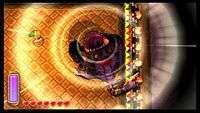 |
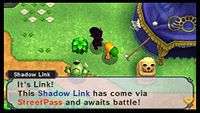 |
 |
With Link’s last two forays into portable gaming proving to be a little underwhelming – although Phantom Hourglass was fun for its time – and his newest outing originating as a remake of A Link to the Past, you could be forgiven for thinking that his 3DS debut – if you discount the Ocarina of Time remake – could have gone either way. However, while it may not prove to become as iconic as Link’s Awakening DX or both of the Oracle titles, it’s easily the most fun I’ve had with an original hand-held Zelda since the latter two were released. It cleverly employs nostalgia without ever overly relying on it, reinvents the formula and gives the player greater freedom at the cost of some difficulty and some nuance in the puzzles. A Link Between Worlds is a fantastic return to form for Link’s portable adventures, and shows there’s plenty of life in the series yet.
Pros- A great art style that manages to bring the world of A Link To The Past to life, while also making it wholly its own.
- Often beautiful orchestrated soundtrack, with some haunting guitar and flute renditions to boot.
- Renting and buying items instead of finding them in dungeons provides players with more freedom than previous titles.
- StreetPass battle is an excellent idea with plenty of potential.
- Effectively employs nostalgia without ever having to rely on it...
- ...Meaning it's still accessible to newcomers to the series and those who aren't obsessive over lore.
- Lots to do outside of the main quest, with plenty of reasons to explore.
- Masterfully paced, causing plenty of reasons to pick up and play for short bursts, as well as giving that "one more go" sensation that can keep you hooked for hours.
- Difficulty seems to plateau halfway through.
- With a few exceptions, there aren't as many memorable puzzles or bosses this time around.
- Hunting Maimais and getting every StreetPass medal may prove a bit of a grind for those attempting to do absolutely everything.
With the series often criticised for rigidly adhering to the same formula - even though each title couldn't be more different - many would be forgiven for assuming that A Link Between Worlds would tread the same path, especially considering its ties with A Link To The Past. In fact, Between Worlds' greatest achievement is the way it employs nostalgia as a guise to draw the player in and then exploits it to cloak some of the series' biggest revolutions, almost as though to soften the evolution to the most hardcore. Although some changes aren't as fine-tuned as they may be in future, their presence should be more than comforting, as it proves that there's still plenty of potential in the land of Hyrule yet to come. Remakes aside, this is easily the best portable Zelda of the last decade.
Last five articles by Edward
- Best of 2015: Journey's End: A New Beginning
- Journey's End: A New Beginning
- You Can't Choose Your Happy Ending
- Okay, Let's Fix Comedy In Games - The V-Effekt
- Time Keeps On Smashing Away























There are no comments, yet.
Why don’t you be the first? Come on, you know you want to!